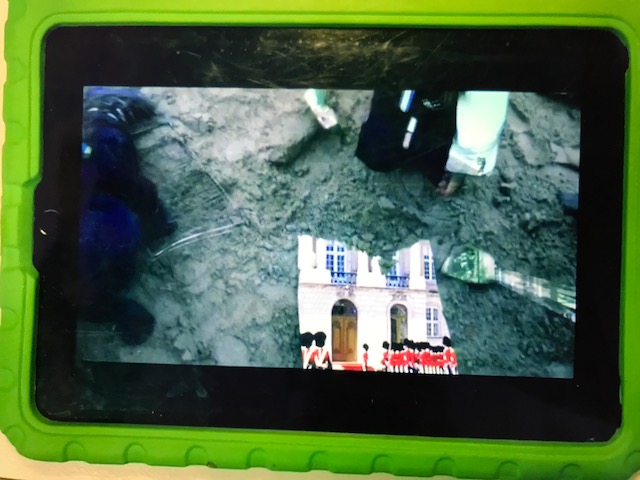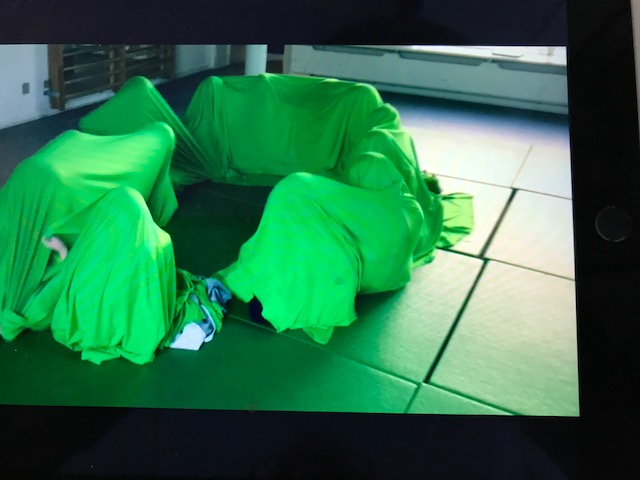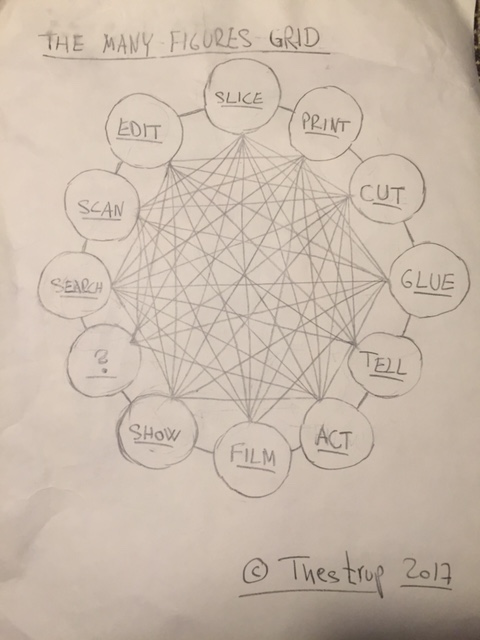Dear Gerrit. You and I have on some occasions discussed the future curriculum of pre-school teachers in Europe and especially on how kindergartens and makerspaces can use the possibilities of the Internet. Here is an open answer with some reflections on the subject. You are leading the Erasmus+ project, Mini-Maker, where I take part. Not all users of this blogpost might know the project, so just a few words on it. The goal is to develop a curriculum for a course for pre-school teachers in Europe on digital media competences. Makerspaces play an important part in the development of this future curriculum. One can follow the project on among others this website (http://mini-maker.de/en/#home).
My question to you and me is at the moment like this: What should the pre-school teacher know and be able to do when he or she together with the children in a makerspace situated in a kindergarten start to use the internet and its possibilities for communication, play and production?
Combining?
When I started thinking about and trying out ways of making a kindergarten and a makerspace connect with the world outside, I started seeing one serious challenge on how to do it. The pedagogical space around the kindergarten was defined as the very physical space of the kindergarten itself. The kindergarten was a closed entity where materials, processes and purposes did fit together. The fence around the kindergarten was also the fence around the everyday activities, the space inside and the playground outside.
The challenge is when you introduce digital media, they open for a lot simultaneously. There is the question of how to actually use any given technology in itself, but also how to combine this technology with other existing or emerging technologies? The question is also how to combine the new elements with the elements already in place in the single kindergarten? How to combine with f. ex. drawings, drama or the existing use of cameras and the number of exercises, introductions, activities and traditions already going on?
What makes it even more complicated is, that the use of all the apps on a tablet or a mobile might change the very use of these new offerings. It is not only the existing possibilities that might change, it is also the new ones. Think of the combination of existing and new cultural practices as exactly that. Through experiments with materials and processes new cultural and pedagogical practices might emerge, where nothing is left untouched and nothing is left unnoticed.
Well, it does not need to be that complicated to combine analogue and digital, online and offline, screen and floor. Have a look here:
Connecting?
What makes it more complicated is the way digital media and technologies already are understood in the single kindergarten when focus starts to point towards how kindergartens or pre-schools might be situated in the world. Children and pre-school teachers are together in these spaces and according to the activity they use body, space and materials together. They move, run, play, draw, think, talk together. There is nothing wrong with all this in itself. The challenge seems to arrive, when all these everyday activities are supposed to connect to the outside world.
Especially when one think of communicating with someone somewhere else, one might get challenged. Here you include actual people in the world, who at first glance might think or act partially or completely different from yourself – or they even seem the same as you. But you know that in advance. They might understand pedagogy, children & digital media differently than you do and that is no matter if you are communicating with a kindergarten close by or far away or if you are communicating with someone outside any educational system. When you move outside your own familiar educational system, you meet people with viewpoints and practices around pedagogy even though they are not trained in any educational system.
The point is not that understanding is impossible or that any culture is static, but that you have reflect on differences and likeness when you meet. Both are there and in the process of encountering you see not only someone else but also yourself. If nothing else your own values and everyday practices might come to the foreground. You don’t need to change anything in your own life, but you start wondering and talk about it – and then you might start to change or get changed. And that is maybe the main point here: If you meet somebody in a shared online universe, you and the ones you meet, might be able to build a common understanding and start supporting the projects of each other. If one understands culture as meaning making process, one also has access to a process, where the participants create the very culture, they are in (Gauntlett & Stjerne Thomsen 2013).
Communication?
Skype or similar systems has often surfaced in the projects, I have been and is part of, when talking about communicating. Which is interesting, as there are so many others ways of communicating. Maybe it has to do with that it seems to be similar to the communication, that goes on in a kindergarten. Which it is not. Skype or the alike is a communication system that shapes the encounter between us, if one is not aware of it. You can´t touch each other for one thing and you can´t easily get an overview of the space where the other side is situated. You can see each other´s faces, but depending on the hardware you choose, you can´t see much more than that even if you start moving the hardware you are using around.
It is a bad replacement for the activities going on in a kindergarten, but if you use the channel for what it can do well or try to find other ways of using it than intended, then Skype can become a useful tool for communicating.
Why look at faces? Why not fingers or objects or dolls and make some kind of doll theatre together, where each side controls one doll? Why not make a hide-and-seek game out of the situation that it is difficult to get an overview? Why not combine Skype with something else like when children are playing a computer game or Minecraft and simultaneously talking to each other through another channel?
Why not combine the synchronous communication with the asynchronous and produce DIY-videos, that others can comment, use, change or make new DIY-videos based on and then talk about with others through Skype? It is maybe here that the makerspace in a kindergarten comes in and has its distinct place. One can build, tell and film as much as one wants. One can look at videos, images and texts made by someone else, even the ones, one does not know in advance, get inspired, dazzled and challenged to do the same or something different. You make something, remake what you see and support other´s if needed be in understanding what you do. (Gauntlett 2015).
Talking in itself seems to be the hardest to do. Doing something together is much easier. It is not only the software or the hardware that frames our use of a given technology, it is also the users and their expectations, that frame this use. It could be part of a European curriculum to experiment with on how to use asynchronous and synchronous communication together with body, space and play and make this approach part of any activities in a makerspace or in a kindergarten. Reflections, questions and suggestions for pre-school teachers can be found here:
Curriculum?
I suggest that a curriculum for the future must contain the ability to act in it and potentially change it as the only constant. I have framed this as Next Practice Labs (Thestrup & Sandvik 2017, Thestrup et all 2015). The laboratory is understood as a laboratory for the next practice and is situated in the very practice it is there to change. It can be at a certain defined place but it can also be a way of thinking and acting activated in the very moment needed by the group of people involved. The lab can be anywhere, also partly or totally online.
The next practice lab is based on two other terms: The experimenting community (Caprani & Thestrup 2010) and the open lab (Robinson & Thestrup 2016, Thestrup & Robinson 2016). The experimenting community has to do with that the community is together in experimenting and not only repeating already existing practice and that both pre-school teachers and children are inside the process and ask questions and look for answers. The open lab is open to combine and transform in principle all materials, all media and all narratives into new cultural practices – and open to the world outside the lab, the makerspace or the kindergarten.
The next practice lab is inspired by the idea of the third space, a certain space, that is between school and home, where rules and actions more easily can be defined by the users (Potter & McDougal 2017), Deweys position on experience a center for the learning process and school as part of life (https://brocku.ca/MeadProject/Dewey/Dewey_1907/Dewey_1907c.html), Lave & Wengers position on situated learning where the learning process takes place in a certain social and cultural context (Lave & Wenger 1991), taking the term Communities of practices to the very core, where a group of people on a regular basis wants to learn from each other (http://wenger-trayner.com/introduction-to-communities-of-practice/). The potential of this position is that any group of people have the agency to decide for themselves what they want to investigate, when, how and what they need to be able know and do, including using digital media and technologies.
These Next Practise Labs could be the constant in the curriculum and in the future practice in a makerspace in a kindergarten. Any new technology or narrative with existing practices around it could be exposed to these labs. Through these labs pre-school teachers and children could together establish their own way of communicating, playing, experimenting and producing. It relates directly to the fact that connecting with the world outside the makerspace is nothing new. It is directly mentioned in the fablab-charter, that all the Fab labs together is a global network consisting of local labs (http://fab.cba.mit.edu/about/charter/). It was part of the early history to let labs across the globe design and produce together (Gershenfeld 2012). In recent literature on makerspaces one can find several different examples of makerspace going online (Peppler, Halverson & Kafai 2016). So the sails for showing, testing and discussing examples in a future curriculum are already set.
Best Klaus
Bibliography
Caprani, O. & Thestrup, K. (2010). Det eksperimenterende fællesskab – Børn og voksnes leg med medier og teknologi in Vol. 3, Number 5, p. 1-39
Gauntlett, D. (2015). Making Media Studies: Peter Lang
Gauntlett, D. & Stjerne Thomsen, B. (2013). Cultures of Creativity:
http://www.legofoundation.com/ko-kr/research-and-learning/foundation-research/cultures-creativity, accessed on 08.07.2017
Gershenfeld, N. (2012). How To Make Almost Everything: Foreign Affairs, Vol 91, number 6, p. 43-57
Lave, J.; Wenger, E. (1991). Situated Learning – Legitimate Peripheral Participation. Cambridge: Cambridge University Press
Peppler, K., Halverson, E. R. & Kafai, Y. B. (ed.) (2016). Makeology: Routledge
Potter, J. & McDougal, J. (2017). Digital Media, Culture & Education: Palgrave Macmillan
Robinson, S. & Thestrup, K. (2016). Inside the rainbow. Accessed on 02.07.2017 https://youtu.be/YdBekYIC6Hk?list=PLAVS-GEyIPCiFaRypx-1drdEuSxuuvAe2
Støvelbæk, F. & MediaPLAYINGcommunities (2009). mPc – is what you see: MediaPLAYINGcommunities. Accessed on 10.08.2017 on https://vimeo.com/54000795
Thestrup, K. Andersen, M.A., Jessen, C., Knudsen, J. & Sandvik, K. (2015). Delaftale 3: Dannelse I en digital og global verden – digitale redskaber skal understøtte barnets lærings- og dannelsesproces. Accessed on 07.07.2016 http://www.kl.dk/PageFiles/1321042/Delrapport%203%20-%20Dannelse%20i%20en%20digital%20og%20global%20verden.pdf
Thestrup, K. & Robinson, S. (2016). Towards an entrepreneurial mindset: Empowering learners in an open laboratory. Emerald Group Publishing Limited. Kap. 8, s. 147-166 (Advances in Digital Education and Lifelong Learning, Vol. 2)
Thestrup, K. & Sandvik, K. (2017). Challenging Makerspaces: Paper, Nordmedia, aug. 2017




